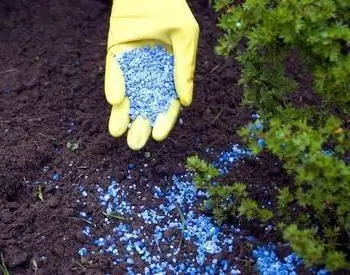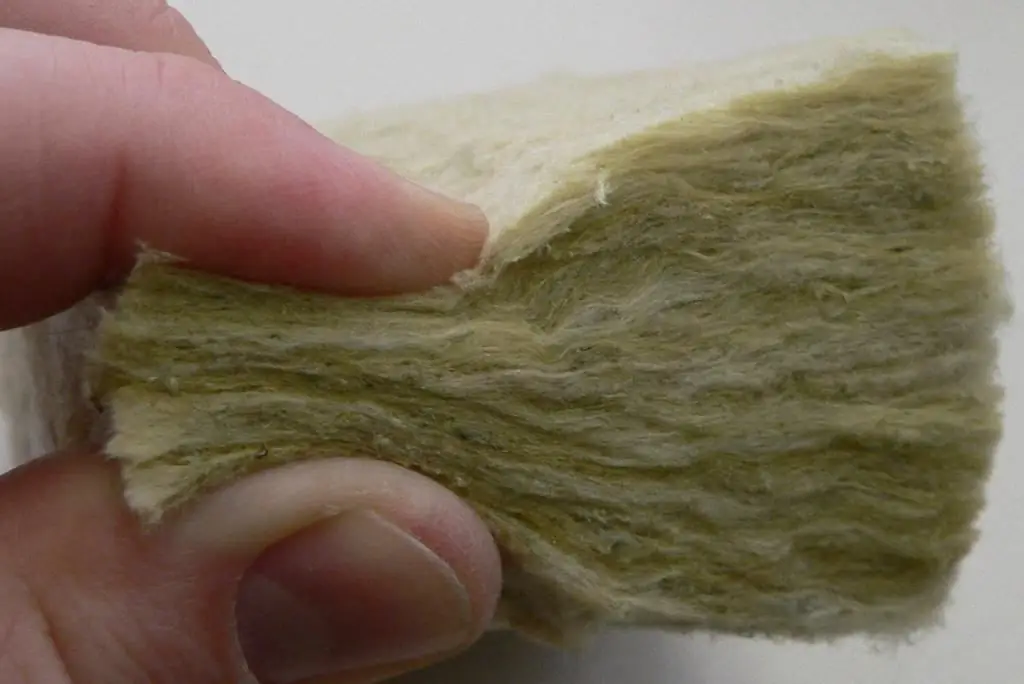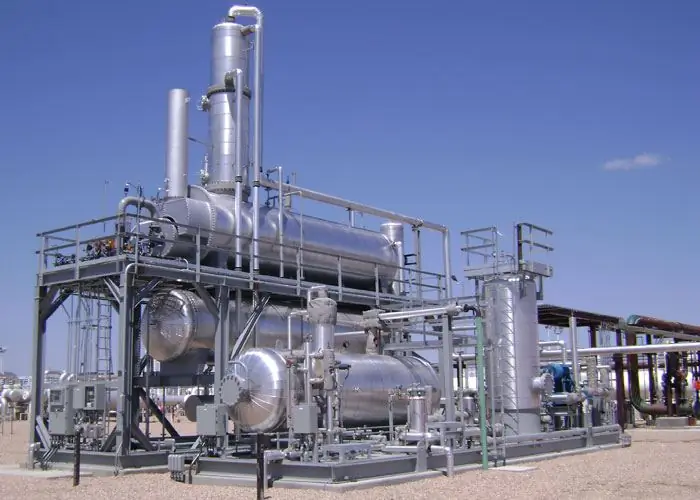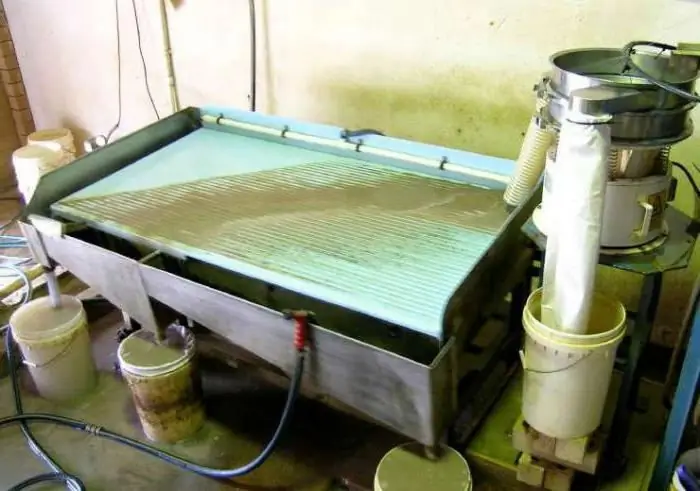2025 Author: Howard Calhoun | [email protected]. Last modified: 2025-01-24 13:10:30
When looking at commercial valuable minerals, the question rightly arises of how such an attractive piece of jewelry can be obtained from primary ore or fossil. Especially taking into account the fact that the processing of the breed as such is, if not one of the final, then at least the process of refining preceding the final stage. The answer to the question will be the enrichment of minerals, during which the basic processing of the rock takes place, which provides for the separation of a valuable mineral from empty media.

General enrichment technology
Processing of valuable minerals is carried out at special enrichment enterprises. The process involves the performance of several operations, including preparation, direct splitting and separation of rock with impurities. In the course of enrichment, various minerals are obtained, including graphite, asbestos, tungsten, ore materials, etc. It does not have to be valuable rocks - there are many factories that process raw materials, which are later used in construction. One way or another, the foundations of mineral processing are based on the analysis of the properties of minerals, which also determine the principles of separation. ToIn a word, the need to cut off different structures arises not only in order to obtain one pure mineral. It is common practice when several valuable breeds are derived from one structure.
Rock crushing
At this stage, the material is crushed into individual particles. The crushing process uses mechanical forces to overcome internal cohesion mechanisms.

As a result, the rock is divided into small solid particles that have a homogeneous structure. In this case, it is worth distinguishing between direct crushing and grinding technique. In the first case, the mineral raw material undergoes a less deep separation of the structure, during which particles with a fraction of more than 5 mm are formed. In turn, grinding ensures the formation of elements with a diameter of less than 5 mm, although this figure also depends on what kind of rock you have to deal with. In both cases, the task is to maximize the splitting of grains of a useful substance so that a pure component is released without a mix, that is, waste rock, impurities, etc.
Screening process
After the crushing process is completed, the harvested raw material is subjected to another technological impact, which can be both screening and weathering. Screening is essentially a method of classifying the obtained grains according to their fineness. The traditional way of implementing this stage involves the use of a sieve and a sieve provided with the possibility of calibrating the cells. During the screening process, they separatesupralattice and sublattice particles. In some way, the enrichment of minerals begins already at this stage, since some of the impurities and mixed materials are separated. A small fraction smaller than 1 mm is screened out and with the help of the air environment - by weathering. A mass resembling fine sand is lifted by artificial air currents, after which it settles.

In the future, particles that settle more slowly are separated from very small dust elements lingering in the air. For further collection of derivatives of such screening, water is used.
Enrichment processes
The beneficiation process aims to isolate mineral particles from the feedstock. In the course of such procedures, several groups of elements are distinguished - useful concentrate, tailings and other products. The principle of separation of these particles is based on the differences between the properties of useful minerals and waste rock. Such properties can be the following: density, wettability, magnetic susceptibility, size, electrical conductivity, shape, etc. Thus, enrichment processes that use the difference in density involve gravitational separation methods. This approach is used in the processing of coal, ore and non-metallic raw materials. Enrichment based on the wettability characteristics of the components is also quite common. In this case, the flotation method is used, a feature of which is the possibility of separating thin grains.
Also uses magnetic mineral processing, whichallows you to isolate ferruginous impurities from talc and graphite media, as well as purify tungsten, titanium, iron and other ores. This technique is based on the difference in the effect of a magnetic field on fossil particles. Special separators are used as equipment, which are also used to restore magnetite suspensions.

Final stages of enrichment
The main processes of this stage include dehydration, pulp thickening and drying of the obtained particles. Selection of equipment for dehydration is carried out on the basis of the chemical and physical characteristics of the mineral. As a rule, this procedure is performed in several sessions. However, it is not always necessary to do so. For example, if electrical separation was used in the beneficiation process, then dehydration is not required. In addition to the technological processes for preparing the enrichment product for further processing processes, an appropriate infrastructure for handling mineral particles should also be provided. In particular, the appropriate production service is organized at the factory. In-shop vehicles are being introduced, and water, heat and electricity supplies are being organized.
Equipment for Enrichment
At the stages of grinding and crushing, special installations are involved. These are mechanical units that, with the help of various driving forces, have a destructive effect on the rock. Further, in the screening process, a sieve and a sieve are used, which providethe possibility of calibrating the holes. Also, more complex machines are used for screening, which are called screens. Direct enrichment is carried out by electric, gravity and magnetic separators, which are used in accordance with the specific principle of structure separation. After that, drainage technologies are used for dehydration, in the implementation of which the same screens, elevators, centrifuges and filtration devices can be used. The final step usually involves the use of heat treatment and drying.

Waste from the enrichment process
As a result of the enrichment process, several categories of products are formed, which can be divided into two types - useful concentrate and waste. Moreover, a valuable substance does not necessarily have to represent the same breed. It also cannot be said that waste is an unnecessary material. Such products may contain valuable concentrate, but in minimal quantities. At the same time, further enrichment of minerals that are in the waste structure often does not justify itself technologically and financially, so the secondary processes of such processing are rarely performed.
Optimal enrichment
Depending on the enrichment conditions, the characteristics of the starting material and the method itself, the quality of the final product may vary. The higher the content of a valuable component in it and the less impurities, the better. The ideal ore beneficiation, for example, provides for the complete absence of waste in the product. This means that in the process of enrichment of the mixture obtained by crushing and screening, litter particles from barren rocks were completely excluded from the total mass. However, it is not always possible to achieve such an effect.

Partial mineral processing
Under partial enrichment is understood the separation of the size class of the fossil or the cutting off of the easily separated part of the impurities from the product. That is, this procedure does not aim to completely purify the product from impurities and waste, but only increases the value of the source material by increasing the concentration of useful particles. Such processing of mineral raw materials can be used, for example, in order to reduce the ash content of coal. In the process of enrichment, a large class of elements is isolated with further mixing of the unenriched screening concentrate with a fine fraction.
Problem of loss of valuable rock during enrichment
As unnecessary impurities remain in the mass of useful concentrate, so valuable rock can be removed along with waste. To account for such losses, special tools are used to calculate the allowable level of these for each of the technological processes. That is, for all methods of separation, individual norms of permissible losses are developed. The allowable percentage is taken into account in the balance of processed products in order to cover discrepancies in the calculation of the coefficient of moisture and mechanical losses. Such an account is especially important if ore enrichment is planned, during which deep crushing is used. Accordingly, the risk of losing valuableconcentrate. And yet, in most cases, the loss of useful rock is due to violations in the technological process.

Conclusion
Recently, valuable rock enrichment technologies have made a significant step in their development. Both individual processing processes and general schemes for the implementation of the department are being improved. One of the promising directions for further advancement is the use of combined processing schemes that improve the quality characteristics of concentrates. In particular, magnetic separators are combined, as a result of which the enrichment process is optimized. New methods of this type include magnetohydrodynamic and magnetohydrostatic separation. At the same time, there is a general tendency for the deterioration of ore rocks, which cannot but affect the quality of the resulting product. An increase in the level of impurities can be combated by the active use of partial enrichment, but in general, an increase in processing sessions makes the technology inefficient.
Recommended:
Mineral fertilizers. Plant of mineral fertilizers. Complex mineral fertilizers

Any gardener wants to get a good harvest. It can be achieved on any soil only with the help of fertilizers. But is it possible to build a business on them? And are they dangerous to the body?
Coal enrichment - features, technology, rules and scheme

Today, mankind uses coal in many areas of its activity. However, not everyone knows that this resource needs additional processing. Enrichment of coal is the most important process, without which the coal industry cannot do
Mineral wool density: classification, advantages and disadvantages, purpose of mineral wool and application

Mineral wool is the most popular type of insulation for an apartment or house. Today it is used by everyone, from builders to the owner of the apartment, who wanted to insulate the room. The simplicity of its installation allows you to immediately insulate the entire house (ceiling, walls, floor). We will study the features and characteristics of the named material further in the article
Gas drying: definition, characteristics, methods and types of work, application of installation and special equipment

Gas drying is one of the cleaning methods that helps to get rid of moisture inside the pipeline. Its appearance is quite dangerous, as it causes corrosion of the metal. In addition, since mining is also carried out in conditions of low temperatures, ice formation is possible
Welding of copper and its alloys: methods, technologies and equipment

Copper and its alloys are used in various sectors of the economy. This metal is in demand due to its physicochemical properties, which also complicate the processing of its structure. In particular, the welding of copper requires the creation of special conditions, although the process is based on fairly common thermal treatment technologies

